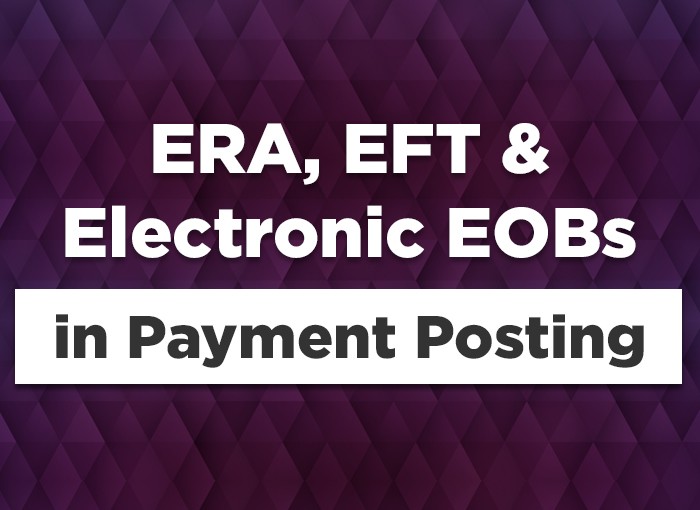Understanding ERA, EFT & Electronic EOBs in Payment Posting of Medical Billing
Payment posting as the last part of revenue cycle management. It deals mainly in the processing of Explanation of Benefits (EOB) and reimbursements from insurance companies. The EOB includes details related to each payment, which are crucial to the services provided, and has to be updated in the billing software. However, manual data entries are prone to errors, which can further lead to claim denials. To overcome this issue certain electronic methods were introduced to the medical billing industry i.e. ERA, EFT & Electronic EOBs.
ERA
Electronic Remittance Advice (ERA) is an electronic report sent by insurance companies (both federal as well as private insurance plans like Medicaid, Medicare, Blue Cross, Humana, Delta Dental, MetLife, etc. to the medical service providers. ERA contains details such as:
- Paid Claims
- Claim Status
- Amount Reimbursed
- Reimbursed amount adjustments based on agreements, secondary payers, benefits coverage, expected copayments and coinsurance.
- Reasons for claim denial along with denied codes and services
- Patient financial liability that has been applied
- Bundling or splitting of payments
- Payment method, such as check, electronic funds transfer
The establishment of ERA eliminates the need for collecting mail, filing paper documents, manually posting payments, and speaking with payers. Managing the data digitally helps medical practitioners to scrutinize the data, spot, and eradicate bottlenecks easily. The ERA report provides valuable insights on claim status, errors in submission, etc., which can further bolster future claim submission and clearance.
The manual payment posting procedure can cost up to $15,000 annually. ERA, on the other hand, drastically reduces paper & printing cost, storage & maintenance cost, as well as administrative costs, along with facilitating better time management for the staff. Furthermore, with ERA, any error in claims are communicated immediately with the medical practitioner, which otherwise could take up to 60 to 120 days.
ERA can be responsible for monitoring, analyzing, and managing revenue cycles more efficiently and thus having better denial management and payment collection systems. It buttresses the payment posting procedure and reduces the claim denial ratio substantially.
As ERA comes under HIPAA guidelines, it provides additional safety and security to the data and reports handling and transfer.
EFT
Electronic fund transfer (EFT) is used by insurance agencies to reimburse claim amounts directly to the account of the medical service provider. In the EFT procedure, an electronic message is sent by the insurance companies to a financial agency (ACH Network) to complete an online payment transaction. The EFT message includes:
- Amount to be paid
- Name and identification of the payer and payee
- Bank accounts of the payer and payee
- Routing numbers
- Date of payment
EFT is a faster, secure, and efficient way to deposit reimbursement amounts when compared to checks. EFT is highly beneficial for medical practitioners as it allows a better way for the management of multiple accounts and payments from different insurance companies. Because of the online data availability, the completed transaction can easily be compared to remittances, which can be accessed online anytime, as well as printed, if required. Additionally, the files can further be downloaded into any of the preferred management systems resulting in the elimination of any manual data entry.
EFT is a highly reliable & confidential money transfer gateway with strict user access and control, eliminating any risk of inaccurate credit deposits and payment loss. Most EFTs are done via ACH Network (Automatic Clearing House), which holds a place at the center of U.S. Commerce. Furthermore, it provides easier access to the payment and reduces cash flow’s turnaround time subsequently.
Mostly EFT & ERA are used together. ERA contains the claim report and detail which is followed by the EFT payment enabling automated payment posting and reconciliation. It is a convenient and cost & time saving method for payment posting procedure.
Electronic EOB
Explanation Of Benefits (EOB) is manual documentation of the report sent by the insurance companies to the medical service providers which includes data like:
- paid claims
- claim status
- amount reimbursed & adjustments
based on agreements, secondary payers, benefits coverage, expected copayments, coinsurance and explanation of claim denial, along with denied codes and services, patient financial liability that has been applied, bundling or splitting of payments, payment method, such as check, electronic funds transfer etc.
Furthermore, mailing and receiving this report manually can take up to 60-90 days. Additionally, this way of reporting is highly susceptible to errors, data loss, damage, and breach. This is where electronic EOBs come into play.
Electronic EOB is nothing but a synonym of ERA (Electronic Remittance Advice). It is simply a digital version of the EOB report, consisting of all the details in a digital format, which can be sent to the medical service provider immediately.
These technologies are the solution to the cost burden on the medical industry, where 24% of each dollar is spent on administrative and paper-work related to RCM. However, understanding and handling all these procedures proficiently requires hands-on experience on these technologies as well as continuous upgradation. This could become tiresome for medical practitioners when added to other daily tasks.
Therefore, medical practitioners prefer to outsource these medical billing services from experienced companies. This way, the data is efficiently handled by professionals and thus contribute to lowering the claim denial ratio and increasing the cash flow for their practices.




